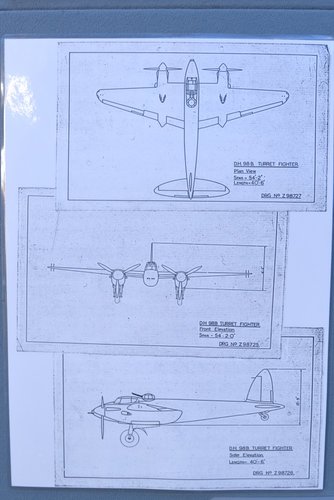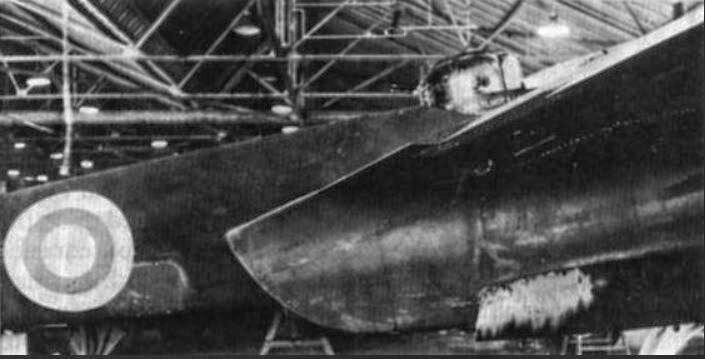nuuumannn
Cannae be ar*ed changing my personal text
- Joined
- 21 October 2011
- Messages
- 276
- Reaction score
- 538
Hi everyone, as I have mentioned in the Mosquito unbuilt variants thread, de Havilland did in fact build two Mosquitoes fitted with gun turrets, so the subject doesn't fit within that thread, therefore I have decided to create this thread for relevant information. Very few books and official sources mention the turret fighter Mosquitoes, most devote a paragraph or two to the subject, almost dismissively, but include little detail as to the whys and wherefores. I have been piecing together information on the subject because so little is offered in public, yet it is very much a part of the Mosquito story, if not a commonly explored one.
Accompanying the dearth of text on the turret fighter Mossie paragraphs are often the same images, of the prototype fitted with a dummy turret for aerodynamic trials and a grainy image of the fourth prototype with a Bristol turret fitted, but other than that there has been very little released that show the installation or the general impression of the aircraft. To date, no one has produced a profile of the turret fighter Mosquitoes that I can find and it would be nice to see such a thing. I have located an illustration, included with this thread, of official drawings of the DH.98B as it is named, which I saw on a panel poutside The People's Mosquito stand at a Shuttleworth airshow a couple of years ago.
When I discussed the aircraft with those in the stand, their take was that the drawings were for a defensive position for a bomber variant, despite the title clearly stating the aircraft was a turret fighter, not a bomber. This is where things get a bit murky. Specification F.18/40, which has had mention on this forum was originally written for a fixed gun two-seat night fighter to replace the BP Defiant, dated 10/11/1940, but on 9 December a correction was made in that armament was changed to incorporate a 'dorsal power-operated turret'. Clearly what the Air Ministry considered acceptable armament for a night fighter had changed.
This led me to dig deeper and in a couple of sources, including Buttler's BSP Fighters and Bombers 1935 - 1950 (Midland, 2004) I found reference to de Havilland being asked to examine the spec, even though the firm was not invited to tender to it. The result was the two turret fighter Mosquitoes, the fourth prototype W4053 built at Salisbury Hall and flown from there to Hatfield with the turret fitted on 14 September 1941, and W4073, first flight 5 December from Hatfield. DH also did much research into Mosquitoes fitted with turrets as a result, to discover that a considerable amount of performance was lost as a result of the installation. My understanding was that GDeH was lukewarm to the proposal, not surprisingly.
Anyway, I have written an article for a local aviation magazine and to honour the publisher I won't be reproducing it here, but will include snippets if need be, since I am the copyright holder. If anyone has information or importantly further illustrations of the two turret fighter Mossies, which, after having their turrets removed went on to become the prototype T.III trainers, which again, is very rarely touched on that the T.III prototypes started life armed with gun turrets, please feel free to post here. This is so I can plagiarise your efforts and include it within my own research!
Seriously though, the turret fighter Mosquitoes are elusive additions to the Mosquito story and it would be welcome to produce more information on the subject.
Accompanying the dearth of text on the turret fighter Mossie paragraphs are often the same images, of the prototype fitted with a dummy turret for aerodynamic trials and a grainy image of the fourth prototype with a Bristol turret fitted, but other than that there has been very little released that show the installation or the general impression of the aircraft. To date, no one has produced a profile of the turret fighter Mosquitoes that I can find and it would be nice to see such a thing. I have located an illustration, included with this thread, of official drawings of the DH.98B as it is named, which I saw on a panel poutside The People's Mosquito stand at a Shuttleworth airshow a couple of years ago.
When I discussed the aircraft with those in the stand, their take was that the drawings were for a defensive position for a bomber variant, despite the title clearly stating the aircraft was a turret fighter, not a bomber. This is where things get a bit murky. Specification F.18/40, which has had mention on this forum was originally written for a fixed gun two-seat night fighter to replace the BP Defiant, dated 10/11/1940, but on 9 December a correction was made in that armament was changed to incorporate a 'dorsal power-operated turret'. Clearly what the Air Ministry considered acceptable armament for a night fighter had changed.
This led me to dig deeper and in a couple of sources, including Buttler's BSP Fighters and Bombers 1935 - 1950 (Midland, 2004) I found reference to de Havilland being asked to examine the spec, even though the firm was not invited to tender to it. The result was the two turret fighter Mosquitoes, the fourth prototype W4053 built at Salisbury Hall and flown from there to Hatfield with the turret fitted on 14 September 1941, and W4073, first flight 5 December from Hatfield. DH also did much research into Mosquitoes fitted with turrets as a result, to discover that a considerable amount of performance was lost as a result of the installation. My understanding was that GDeH was lukewarm to the proposal, not surprisingly.
Anyway, I have written an article for a local aviation magazine and to honour the publisher I won't be reproducing it here, but will include snippets if need be, since I am the copyright holder. If anyone has information or importantly further illustrations of the two turret fighter Mossies, which, after having their turrets removed went on to become the prototype T.III trainers, which again, is very rarely touched on that the T.III prototypes started life armed with gun turrets, please feel free to post here. This is so I can plagiarise your efforts and include it within my own research!
Seriously though, the turret fighter Mosquitoes are elusive additions to the Mosquito story and it would be welcome to produce more information on the subject.
Attachments
Last edited:


